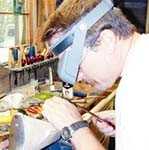Flintlock maker is 'one of the lucky'

BLOOMFIELD - Ending up a full time craftsman of custom flintlocks may have been an accident, but Chuck Edwards of Bloomfield wouldn't have it any other way.
"This is not a business you get rich at, but I'm one of the lucky, fortunate ones that love their job," Edwards said. He estimated there are only around 10-15 top flintlock makers in the United States "who are doing it full time."
Born in Dexter, Edwards has lived most of his life in the Dexter-Bloomfield area. "We took a couple of years living in San Antonio and northern Missouri and came back," he said.
A black powder hunter since the early 1980s and a participant in living history events, Edwards eventually tried his hand at putting together a black powder gun kit himself, but "knew there were guys out there building better rifles."
Edwards tried a few on his own, did some research, and examined original flintlocks at gun shows. His work was getting better and better, but it was something he did on evenings and weekends, completing a one or two in the first year, three the next year.
Eventually it got to the point where Edwards found himself "working every night and weekend out here in the shop."
It was a magazine article by Ted Belue of the University of Kentucky, who had previously had written about Edwards' dyed porcupine quill craft in a Jan. 2001 magazine cover story, that really changed things, however. "I had phones ringing off the hook," he said.
Edwards soon found himself with a year's worth of work lined up crafting the flintlocks and discussed with his wife giving up his regular job to make the guns full time. "It's been two years this August when I finally decided to quit."
And after two years of full-time gun making, Edwards still has a year's worth of work lined up ahead of him, meaning a year to a year and half waiting list for those wanting one of his guns.
The wait, however, is worth it.
The carved gun butts include once-standard features now missing from modern rifles such as cheek rests and the butt being "cast" to the right a few degrees providing for a more natural and comfortable aiming posture.
The flintlocks range from .25 caliber to .90 caliber, with most either being .54 caliber or .50 caliber, according to Edwards. Rifle barrels range in length from 27-56 inches. Edwards' longest so far was 49 1/4 inches.
Edwards gets the gun barrels from John Getz of Beavertown, Pa., and also orders the firing mechanisms, called "locks," from another company but is considering getting into lock building himself. "There's a few earlier locks that are not being produced," he explained.
The gun stock "blanks" are from Tennessee where they are cut out and air dried for six years before being ready for use to minimize the wood's shrinking and expansion.
Gun stocks are made using "mostly curly maple," Edwards said, with a few being walnut. "Every once in awhile I get a piece of cherry."
Excepting the lock, barrel and screws, Edwards makes all the hardware himself. "It's all forged - hand forged," he said: trigger, sideplates, butt plate, trigger guard, nose cap, sights, patch box to keep cleaning jags in and thimbles, which are what hold the 'wiping stick' often called ramrod, below the gun barrel on the stock.
A lot of time is also spent on detail work such as carvings in the butt and the pure silver inlays.
Once the flintlock is complete, the wood and hardware are distressed to customer preference and the flintlock is test fired before being shipped off. "Most want it slightly aged," Edwards said. A few either want him to "highly distress it" or leave it brand-new.
Edwards usually works on one flintlock at a time, finishing one gun every four weeks on average. Finished products are shipped off pretty much as soon as they are done and test fired.
Authentic original flintlocks from the early Indian and Revolutionary wars generally cost between $10,000-$100,000, according to Edwards. "I don't own any - can't afford one. But every once in awhile I get to look at one."
Custom reproductions run from $1,700 on up to $50,000, with the work of a well-known gun maker costing at least $10,000. "Other gun makers are years ahead of me," he said. The cost of a flintlock pistol is the same as a rifle as it is just as complicated and expensive to produce.
For $1,700, a customer can get a flintlock with the "bare essentials," according to Edwards. "It's what you call a 'barn gun.'"
While finer rifles are still found dating back to the 1600s, Edwards hasn't seen a barn gun dating back before 1780. "None of the early original ones survived," he said. "They were used up or left out in the barn."

